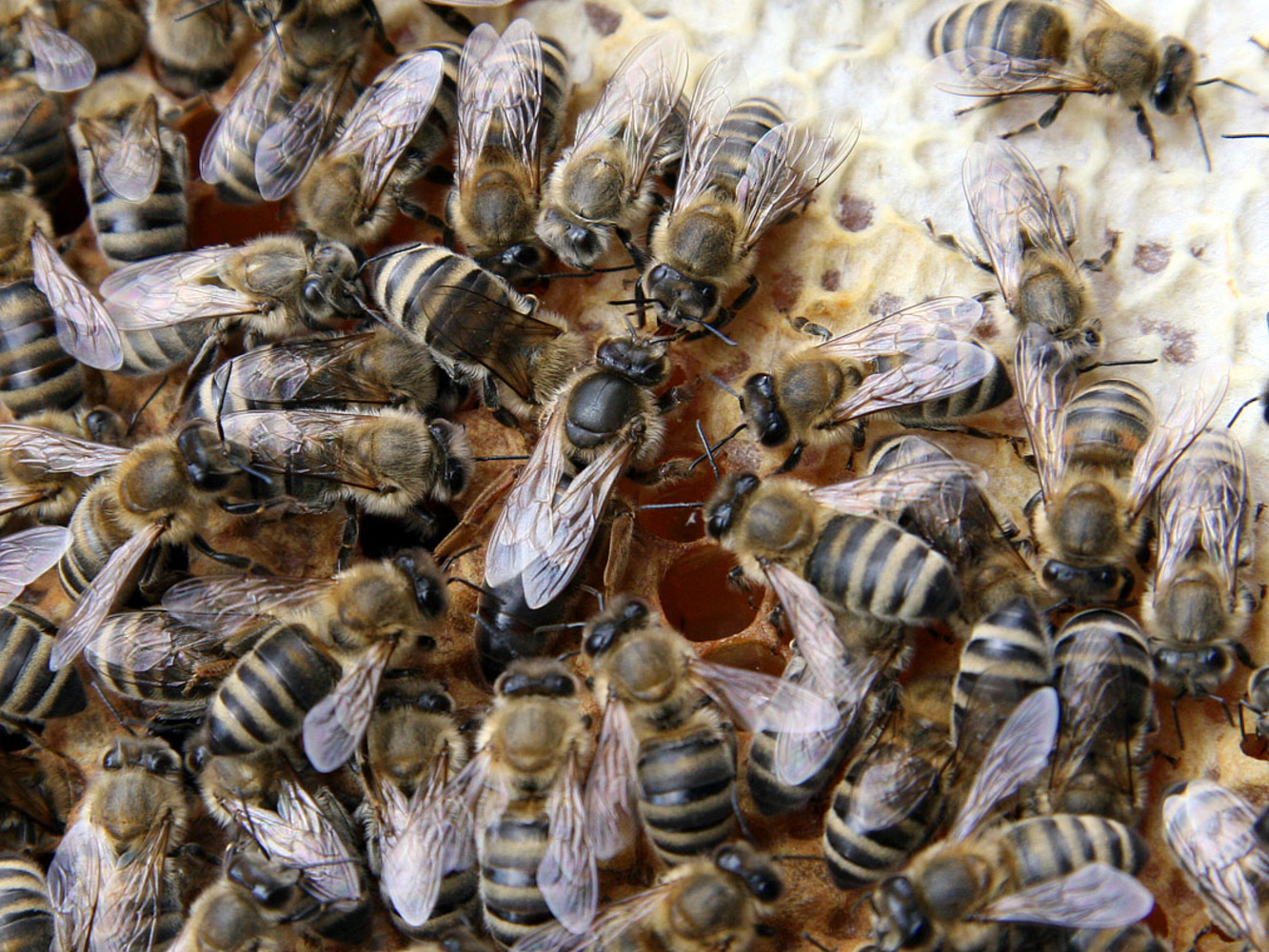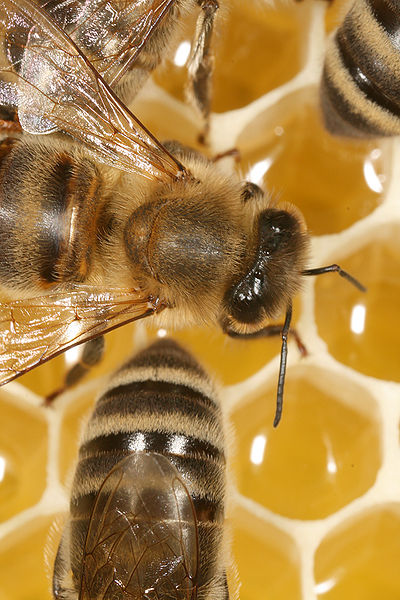Battles Between Bee Sperm
Interview with
Boris - Reproduction in honeybees starts very often when the colony gets fed up with the queen and they execute her, chop her into bits and pieces, and thrown out of the colony. They then use the last eggs which she has laid before, and they start to breed new virgin queens. And When they hatch they are normally separated for a while until everybody has hatched, and then they again fight against each other until one or very few are left.  These queens then leave the colony for what we call a mating flight and they go high up in the air, they release a pheromone, a substance that attracts males, and the males come in large numbers. The ratio between virgin queens and males is really extraordinary in honeybees, about 16,000 males and one female. They all queue up behind her, forming what they call a comet, so they basically queue up for copulations. The female then copulates with about 200 of them, or up to 200 of them. She kind of basically just collects ejaculates, she goes back into the colony, and then she sorts these ejaculates out, but only very few, about 5%, of the sperm that she accumulates during her mating flight will ultimately be stored.
These queens then leave the colony for what we call a mating flight and they go high up in the air, they release a pheromone, a substance that attracts males, and the males come in large numbers. The ratio between virgin queens and males is really extraordinary in honeybees, about 16,000 males and one female. They all queue up behind her, forming what they call a comet, so they basically queue up for copulations. The female then copulates with about 200 of them, or up to 200 of them. She kind of basically just collects ejaculates, she goes back into the colony, and then she sorts these ejaculates out, but only very few, about 5%, of the sperm that she accumulates during her mating flight will ultimately be stored.
Chris - So does she then use that sperm that she selects for the rest of her life because queens can live a long time, years?
Boris - Yes. In honeybees, they can live up to 7 years, in other social insects which we work with they can live for decades. So we know that for example the ants which we use for comparative studies, they can live for about 20 years. They only mate very early in their life. Once they have laid their first egg, once they've initiated a new colony, they will never go out and mate again. This has very dramatic consequences on the female because they have to store immense amounts of sperm, millions and millions. They have to keep it alive for thoe whole time and they have to use it very prudently throughout their lives to fertilise eggs. And it's quite fascinating, how can females, how can queens do this so efficiently?
Chris - So are you any closer to understanding then how they sort out this sperm? How do they decide of all these 100s of matings? "I want that sperm and I'm going to use it in whatever order. I'm going to flick out that sperm, I don't want that." How do they do that?
Boris - I think we started to get first insights into these. The male doesn't only transfer sperm to the female. The male also transfers a secretion which we call seminal fluid or seminal plasma, and that seminal fluid consists of proteins, and when we looked at these proteins, we saw that they could be involved in little warfares between the ejaculates but also between the males and the females. And we tested that in honeybees and what we actually find is that some of these proteins seem to be able to recognise none-own sperm and kill that sperm off in the female sexual tract. In the end, when we replicated that work, we could also study the female side of this and in these ants we found that the female secretions can actually cancel out that little warfare. How you can imagine this happens is that you have a picture in front of you of a gladiator in an arena, the ejaculates then enter that arena which is provided by the female and it's a sexual trap that they fight against each other in. We think the weapon here which they use are these proteins and then you have losers, you have winners, but up there, the spectators, they will be the females, and they make like in the old Rome, they make this really famous sign of thumbs or thumbs down. So they ultimately decide who will win, who will father offspring and who will be chucked out.
Chris - And do we understand what the nature of that biological warfare is? What those proteins are doing and how they're recognising, "This is my sperm. That's a competing sperm. You're dead. My ones are going to survive?"
Boris - That's actually what we have just started working on. We don't know yet what these specific proteins are or what the recognition process is. What we tried from our list to do is to identify those proteins that are there to then test them specifically to find out whether they are responsible for that effect or not. Initially, it sounds weird that a liquid can recognise own from non-own or a simple cell like sperm cell will be able to do this, but there are a couple of studies that have been published over the recent months actually, that all indicate that it's actually something that should be there. There was a similar study that was performed in mice a couple of weeks ago. It was found that sperm in mice is also able to recognise own sperm from non-own sperm. So they basically align themselves to kind of cluster together, but only those from the same male will form that alignment.
Chris - I'm understanding how this works. Presumably, this is going to inform better bee conservation and bee breeding strategies.
 Boris - Yes. That's one of the ideas which we have that deeper knowledge about bee breeding, bee reproduction will help the bee industry to kind of breed better bees and to kind of ship semen samples around for artificial insemination programs, and we have an artificial insemination lab here so we're actually involved in-breeding of more bees or bees of better quality.
Boris - Yes. That's one of the ideas which we have that deeper knowledge about bee breeding, bee reproduction will help the bee industry to kind of breed better bees and to kind of ship semen samples around for artificial insemination programs, and we have an artificial insemination lab here so we're actually involved in-breeding of more bees or bees of better quality.
Chris - So you're effectively creating a bee sperm bank.
Boris - Yes, to a certain degree. The advantage of the bee sperm is that you can keep it in a glass vial for a very long time. It survives for a couple of months without help and at room temperature. So, if you need a lineage which has an increased tollerance or resistance against a parasite, and that's at the moment a big issue, then you can - instead of importing bees which is always risky - you can import semen. For some of the more dangerous diseases that travel around the world in the bees like the Varroa mite or the hive beetle we know that's not present in semen. So we have a lower risk of importing something which we don't want to have here.
Chris - Bee Biologist, Boris Baer - he's from the University of Western Australia.










Comments
Add a comment